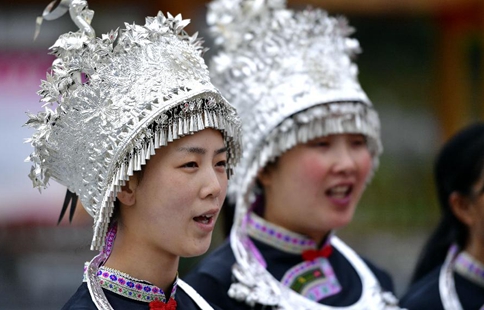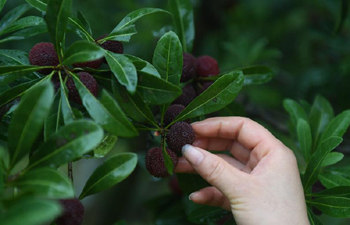
A farmer picks litchi in Luc Ngan district, Bac Giang province, Vietnam, on June 12, 2017. Facing a lean harvest but enjoying good prices, Vietnam's litchi growing hub is intensifying cultivation of the succulent fruit in accordance with international standards, and exporting half of its output to China. (Xinhua/Le Yanna)
by Le Yanna, Bui Long
HANOI, June 15 (Xinhua) -- Facing a lean harvest but enjoying good prices, Vietnam's litchi growing hub is intensifying cultivation of the succulent fruit in accordance with international standards, and exporting half of its output to China.
On Wednesday, an official from Bac Giang's Bureau of Agriculture and Rural Development told Xinhua that the northern province is encouraging more local farmers to grow litchi trees according to GlobalGAP or VietGAP, and promoting the fruit both at home and abroad.
VietGAP is the Vietnamese version of GlobalGAP (Good Agricultural Practices), a voluntary audit which verifies that fruit and vegetables are produced as safely as possible to minimize risks of microbial food safety hazards.
"On June 8, we held a litchi sales promotion conference in Pingxiang in southern China's Guangxi Zhuang Autonomous Region. We hope that in Guangxi, our special 'thieu' litchi will win consumers' hearts," said the official.
Bac Giang is this year maintaining export of both fresh and processed litchi, Duong Van Thai, vice chairman of the provincial People's Committee, said, noting that most of the fresh litchi is exported to China.
Some 40,000 tons of fresh litchi, or 80 percent of the fruit's output earmarked for export this year, will go to China. Other export markets include other Asian countries like Japan, South Korea and Singapore, and some faraway ones, including the United States and Australia.
Luc Ngan district, Bac Giang's biggest litchi growing area, is forecast to produce some 100,000 tons of litchi in 2017, down one-third compared to 2016, said Cao Van Hoan, vice chairman of the Luc Ngan People's Committee.
"During last year's litchi harvest, I bought and resold 900 tons of litchi, but the figure this year can be halved, although the Chinese demand is very high," a middle-aged woman said, pointing to the succulent fruit piled up in her roadside warehouse in Luc Ngan.
With chubby rosy cheeks, Nguyen Thi Hoai from the district's Phuong Son commune, on Monday morning was as busy as a bee driving a hard bargain with litchi growers, and directing her staff to weigh the fruit packed in cylindrical crates made of wood or iron.
"During this litchi harvest, my husband and I are buying 15-18 tons a day, at prices of around 40,000 Vietnamese dong (1.8 U.S. dollars) a kilogram on average. During last year's crop, prices were around 30,000 Vietnamese dong (1.3 dollars)," Hoai told Xinhua.
The local trader attributed the price hike to this year's bad crop due to unfavorable weather conditions.
"Litchi trees need cold weather to blossom, but this year is too hot. Besides, when the fruit was taking shape, heavy downpours tore their skins," explained Giap Van Truong, who sold nearly 50 kilograms of litchi to Hoai on Monday morning.
In a threadbare military uniform, Truong from Bac Giang's Luc Nam district looked like a demobilized soldier, but he has been a genuine farmer for years, growing over 800 big litchi trees.
"Last year, I harvested 15 tons of litchi. But this year, the output will be only four or five tons," he bemoaned, but showing no desperation. His look was as cool as a cucumber, maybe because the fruit's higher prices compensated for the smaller output.
Unlike Truong, who carried a crate of litchi by motorbike to Hoai's warehouse for sale, Nguyen Van Thanh, a 37-year-old grower from Luc Ngan's Giap Son commune, stayed at home, waiting for both Vietnamese and foreign traders.
"My orchard is 1.4 Vietnamese acres (5,040 square meters), with the oldest litchi trees grown in 1979. Right here this morning, I sold the fruit to a trader for 60,000 Vietnamese dong (2.7 dollars) per kilogram. Three days ago, some Thai people came here to survey my orchard," Thanh boasted on Monday, standing upright under a canopy of dark green leaves of an age-old tree as proud as a peacock.
However, his litchi garden, dotted by some dragon fruit and grapefruit trees, is estimated to yield only six tons of litchi this harvest, the peak of which lasts from mid-June to mid-July, compared with 10 tons last year.
To offset the smaller yield, the local farmer has so far this year sold over 10,000 litchi saplings (provined, or extracted, from big trees) at prices of 30,000-40,000 Vietnamese dong (1.3-1.8 dollars).
Dreaming of making a fortune from growing litchi trees, Thanh and his wife plan to develop their "amateur" orchard into a "professional" one in line with VietGAP or GlobalGAP standards.
"Meeting VietGAP standards, our litchi will be better quality, and of course, go for a better price," Thanh said, noting the Chinese market prefers the fruit which is most succulent with a very small seed.
Besides Bac Giang, litchis are grown in the two other northern provinces of Hai Duong and Hung Yen.
In Vietnam's northern Lang Son province bordering China, many shops-cum-warehouses can store 500-1,000 tons of fruit, mostly litchi and longan, each. Every summer, one shop in the province's Dong Dang border town sells, on average, 40 tons of fruit, local traders said.
"Our customers come mainly from Guangxi, Zhejiang, Fujian and Sichuan. They like dried litchi best, then longan pulp and longan," said Bui Thi Men from Hung Yen, who has worked as a fruit trader in the border town's Day Thep area for years.















